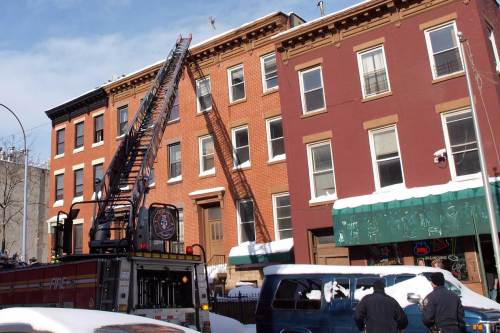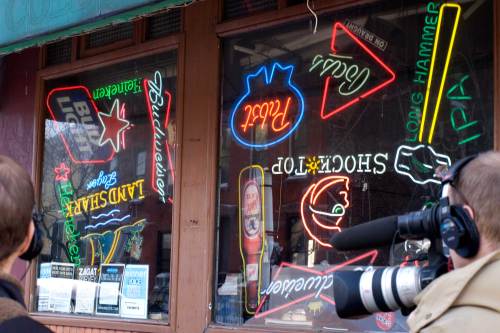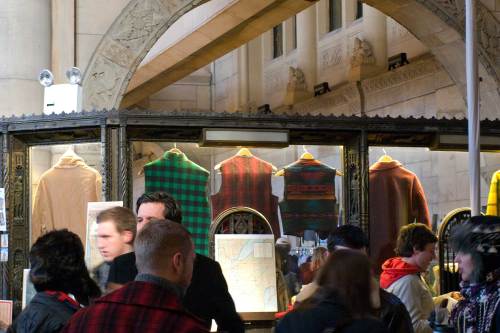Freddy’s Bar, in downtown Brooklyn, is fighting for its survival . . . .
Lately, the bar, and its manager Donald O’finn, have been very successful at getting media attention for the bars’ plight. Everyone from the New York Daily News (appropriately) to the New Yorker have all covered the bar’s fight against eminent domain, Bruce Rattner’s mechanism to seize the land below Freddie’s and the blocks aroud it for the Atlantic Yards Development. Even Fox News had them on for an interview.
I’ve known about Freddy’s since the early 90’s, when it was the local for workers from the Daily News Plant around the corner, though its been around much longer than that. I lived just up Dean and must have stopped in once or twice, but don’t remember much about it – it was very much a working man’s bar, a little anonymous, as busy in the morning as it was in the evening, with all the night workers and drivers coming off their shifts.
When the Daily News shipped out to Queens and, in what would be a foreshadowing of the Brooklyn to come, their former plant was converted into condos, I thought Freddy’s would close. But in what would be another foreshadowing, it was taken over by artist-entrepaneurs who buffed up the old oak bar, brought in bands to play in the back room and turned the bar into the artist/ boho space it continues to be today.
I started hanging out in the very late 90’s, when I still lived in Fort Greene. It was nice having a good bar in walking distance. In those pre-hipster days, there weren’t many bars in Brooklyn with found video loops broadcast on a TV over the bar, or that played the whole Velvet’s Banana album or the Ramones or 80’s British punk. The back room featured everything from hardcore to experimental jazz, and even if it wasn’t a ‘neighborhood’ bar in the sense that the black people up Dean, or the fireman and policeman from the adjacent fire and police stations, seemed to hang out there in any number, it still had the feel of a neighborhood bar. Donald O’finn’s found video loops, featuring everything from early cartoons to shlock horror and snippets from Bruce Lee films, were mesmerizing. A little too mesmerizing – if you went with a friend, your attention would inevitably turn toward the screen, and all conversation would stop.
I still go down occasionally. The bar, like the neighborhood around it, feels besieged and a little standoffish. Freddy’s is something of an icon now, voted best bar in Brooklyn by Time Out among others, and like all icons it has lost its casual feel. Donald Ofinn’s found video still beams from its perch at the front of the bar. For awhile last year, with the Atlantic Yards development at a standstill, I wondered if it would even go through – even the anti-Atlantic Yards/ Eminent Domain abuse clippings in the info box were looking a little worn – but a late November court decision in favor of Rattner has Freddy’s fight a new urgency. The scale of the proposed development is incredible (simulation from 2006) : what is essentially a section of mid-town Manhattan will be dropped in what had been a quiet, largely residential, neighborhood, making central Brooklyn largely unrecognizable.
On a Sunday afternoon before Xmas, Freddy’s held a special event to protest the coming storm. A fire had broken out a few buildings down and fire and police trucks were parked in front, though the fire had been contained with no visible damage by the time I arrived. TV, video and still cameras were present in great numbers, and Donald O’finn was interviewed many times inside the bar and out. “I’m just an artist . . . I’m the last person who should be doing this . . . ” He joked about the fire down the street. “We’ve been assured it was accidental . . .” A chain was put through the bar rail, handcuffs attached, and regulars duly handcuffed themselves to the bar while the cameras snapped and free rounds were handed out. A bartender jumped on the bar and took pictures of people taking pictures. Then more beers were drunk.
When I went down a few days ago, the neon beer signs in the window had been turned upside down. The bar, the chain, and the video along the bar rail were all there, though heavy machinery was edging closer, taking over a lot next door. Freddy survives, but for how much longer is uncertain . . .
More bars of New York:













Brooklyn’s Grand Central Station
Posted in Comment, Fort Greene, Gentrification, New York History, tagged Atlantic Station, Atlantic Terminal, Atlantic Yards, Central Brooklyn on January 16, 2010| 2 Comments »
Underwhelming . . .
This seems to be the consensus among the people I know in Brooklyn (and much of the Brooklyn blogosphere), and I have to concur. Especially after 8 years and $108 million ( 2 and half years late and $16 million over budget). The soaring windows are a nice touch, as is the limestone thing at the top of the stairs, but atmosphere, grandeur, the public space that should be a part of any train stations, are sorely lacking. This is the gateway to Brooklyn and the soon-to-be-constructed Atlantic Yards?
I admit that I was excited, almost despite myself, to see an actual train station finally re-opening where the original Atlantic Station was torn down in 1988. For years after I first moved here in 93, this was a pit in the ground, with a little tin shack to mark the station entrance. You’d descend a filthy stairwell into bedlam – crashing trains, harried crowds rushing though tunnels where the crumbling, mildew-stained concrete walls, blaring announcements and, eventually, a continual backdrop of jackhammers and construction hoardings. It went on for so long I began to think of the noise and unpleasantness as the station’s natural state, and would only go down if I absolutely had to.
So the new station is an improvement on all that. Still – eight years for a few steps, a glass front, some limestone, and three arches leading into a shopping mall?
Because the station, if you can call it that, is part of Atlantic Terminal, a dark and deeply unlovely mall whose chief aesthetic achievement is that it is marginally more atmospheric than the Atlantic Centre behind it, a mall which strives to have no atmosphere at all. When I tried to take a photograph inside Atlantic Terminal, a harried, nervous looking security guard came out and said: “no pictures – they can put you in prison for that,” though I don’t know what ‘they’ are worried about, since, well, it’s a mall. Outside, on Flatbush, is some of the worst traffic in Brooklyn and, traversing the corner of Flatbush and Atlantic, where heavy traffic barrels down six lanes off the Manhattan Bridge then veers north, south and east into Brooklyn, is a deeply unpleasant and even dangerous experience. The Atlantic Yards, and the basketball arena, will only make the traffic, and the notion of being anywhere near that traffic, much, much worse.
The Atlantic Terminal is owned by Bruce Ratner, the same dude behind the aforementioned Atlantic Yards development, which promises to bring a section of mid-town Manhattan to central Brooklyn, and pretty much over-run the two neighborhoods I’ve lived longest in New York, Fort Greene and downtown Brooklyn. From the time I lived around the corner, up behind what was the Daily News Plant, the area has been a pit, so some kind of development is welcome. But if the Atlantic Terminal is anything to go by, Brooklyn is in a lot of trouble.
And the original Atlantic Station? It had an open concourse, benches, and big glass panels on the roof which must have let in the same slightly milky light you find animating the beautiful Victorian stations in England. Like so much fine architecture – the original Penn Station is most notorious example – it was allowed to decay, then someone thought they could make money by developing the site and station was declared beyond repair and torn down. Before construction could get started, the last recession kicked in, the developers ran out of money and left the pit I discovered and wondered about five years later. Thus, thus, has been the way in so many of our cities . ..
You can see photographs of the original station at arrts-arrchives.com (thanks to Brooklyn Born for telling me about the site).
All that remains of the original station is this lonely adjunct, marooned on a traffic island across the street, serving I don’t know what function.
New York Times City Room has a positive if bland take
Read Full Post »